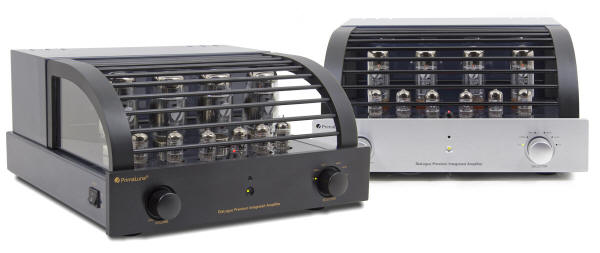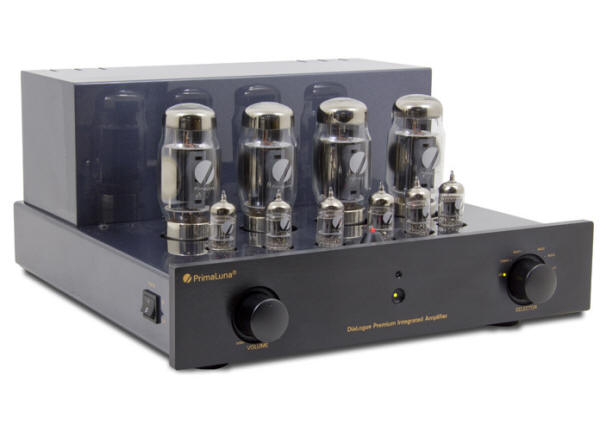|
You are reading the older HTML site
Positive Feedback ISSUE 67
The Neoteric Listener and the PrimaLuna Dialogue
Premium Integrated
"If I buy this for you, will that be it? Will you finally be satisfied with this, or will you just want something else in a year or two?" And that's the bitter truth of it: Even if I had a house full of Lamms and Wilsons and a Caliburn in every room, I'd still be wondering about the Dartzeel I'd heard or the ten dollar SET made by some dude's younger cousin in Rancho Cucamonga. Unfortunately, my whims outpace my wallet, which is one of many reasons why tube amps appeal to me. You can get a great sound now, with the option of later purchasing cheery little glass sonic hedgehogs of all sizes and nationalities, as your fancy and finances dictate. First, though, the amp better sound great and be rugged enough to withstand the pounding incurred by swapping sets of El34s and KT88s. Right on cue, the PrimaLuna Dialogue Premium integrated meets those requirements, and even goes one step beyond by offering the opportunity to enjoy the heavy heavy monster sound of the new KT120 tube that's all the rage.
At slightly over three grand, this newest PrimaLuna integrated boasts exceptional transparency, resolution, and dynamics. For starters, the Dialogue Premium is incredibly quiet, and easily rivals many solid-state brethren in this respect. PrimaLuna touts its exclusive "AC Offset Killer" feature as the answer to reducing transformer hum, but whatever the reason, the Dialogue Premium emits less than half a peep, even when turned fully up. Of course, all that background silence is merely a prelude to what the Dialogue Premium has really got going on: a dynamic soul. I don't just mean the usual audio markers of capacious soundstage, accurate transient retrieval and extended range to convey the subtleties of recorded music––all of which the Dialogue Premium delivers with aplomb. No, what I'm really trying to put on blast is the vibrant immediacy of the PrimaLuna's sound. Perhaps this expressiveness is the tangible result of PrimaLuna's aim at reducing distortion and extending bandwith across the board. And while it's a given that this amp has a warm tone befitting its valve design, it is the liveliness of the presentation that sets it apart. Leontyne Price's rendition of Puccini's "Un Bel Di," ascends with stirring power and palpability. John Lennon's shouts open "Anytime at All" with full-throated resonance and edginess. The driving drum machine woodblocks and rhythm sticks driving the Burning Hotel's indie hit "Beard" propels forward with body and pace. Bonham's fierce kick drum, John Paul Jone's mellotron and Plant's "mystery of the quotient" conjuring all add to an excellent rendition of "The Rain Song," (courtesy of newly acquired first pressing of Led Zeppelin's Houses of the Holy that looks ugly but sounds great). It should be noted that little changes make a big difference with this particular PrimaLuna integrated. Anyone who doubts whether or not cables make any appreciable change in sonic presentation need only perform a cursory listening test using the PrimaLuna integrated. Swapping out my reference Kubala-Sosna Imagination speaker cables for a pair of MG Audio Planus III's audibly changes the character of the sound, as do varying music file sampling rates, interconnects, and power cords. This is a well-designed amp featuring high quality parts (the website touts "ALPS volume control and Takman resistors from Japan, and SCR tin foil capacitors made in France"), so there's always a high standard presentation, but this is not one of those homogenizing amps that makes everything sound uniformly good... and uniformly dull. If your system's bright or the recording sucks, don't expect the pretty tubes to tell you some big ole euphonious lie. Simultaneously breaking in the silver MG Audio Planus IIIs and Planus CU2 interconnects is a bit of challenge, given that most of my music was mixed on a board more often drenched in Guinness than reverb. Still, once the cables hit their stride, this is a combination that makes you stop all that damn multitasking and listen to the music you love. Pivotally, with the right combination of partnering gear and source material, the result can be exquisite. Fortunately, five figure gear and double DSD is not a course prerequisite, as I was able to coax rewarding sound out of standard redbook CDs and my modest system consisting of an Arcam CD82 player, CENtrance DacMini PX, and a pair of Nola Contender speakers. Naturally, higher resolution files or fine vinyl recordings via the Clearaudio Concept turntable in for review significantly moved things up a few notches...
If you're not familiar with PrimaLuna, you should knows that there are a stock number of features for which the company is justifiably held in esteem. Besides the aforementioned first rate quality parts, PrimaLuna touts its Adaptive AutoBias circuitry that "constantly monitor the temperature, voltage and audio signal of the individual power tubes. That data is fed to an active circuitry that determines the correct bias for each one, adapting instantly and continuously to the demand for power and all the other changing variables." Critics of such a system may argue that all that circuitry may somehow impede or alter the signal in a way that limits or colors the sound produced by the amp. Normally, I'd be inclined to agree, but my listening experience found this to be a highly sensitive and transparent integrated, so I guess the design team have done their homework. PrimaLuna offers its own explanation for the Dialogue Premium's signal clarity by stating that "The system is inherently transparent sonically because it contains no extra active or passive parts in the signal path, other than the usual coupling capacitors and grid resistors. Further, steering signals are kept 5 octaves below the audible region." Other PrimaLuna staples include point-to-point wiring, a "Bad-Tube Indicator" that lights up an LED light when a tube needs replacing, power transformer protection, and output transformer protection––all designed to take the fear and loathing out of enjoying tubed amplification for a very, very long time. PrimaLuna claims that its Adaptive AutoBias system increases transparency across the frequency spectrum and reduces distortion by as much as fifty percent to previous versions. As important as the system is for getting better sound, I'd argue that it's almost as important that it enables the user to easily swap out tubes and shape the amp's sound without the need to constantly bias the amp again. The Dialogue Premium's biasing system allows for the use of EL34s, KT88s, and even the trendy KT120s. Moving from the EL34s to the KT88s/120s can be achieved as easily as inserting the tubes and flipping a switch at the side of the amp. When I first turned on the Dialogue Premium with the KT120s, my first words were, "Wow! Talk about waking up your speakers!" The Tung-Sol KT120s sound like KT88s that have just come back from Marine boot camp: bigger, badder, better. Better? Well, not having a set of KT88s to compare them to makes that a bit of conjecture. For the most part, I prefer the warmer, sweeter sound of the EL34s, but KT120s are the current tube equivalent of a Rocketballz titanium driver, and who doesn't want to hit the long ball once in a while? Playing Leo Kottke's forgotten classic Greenhouse LP the Dialogue Premium outfitted with KT120s is a feast of reverberant woody bottom notes and singing slide guitar. While maybe not as rich as the EL34s, I think the overall balance and lower frequency grip of the KT120s better expresses the full range of the the various instruments used on the album (including the always hard-to-convincingly reproduce twelve string guitar). The Dialogue Premium ships with your choice of EL34s, KT88s, or KT120s (on request) already installed. Deciding which tube type is best for your system and listening taste is a conversation that you should have with your PrimaLuna dealer. In any event, there's always room for change, and for more variety, the Dialogue Premium allows you to change the mode from Triode to Ultra-linear at the push of a remote button. While the triode mode does sound a little warmer for some recordings, I mainly preferred Ultra-linear for my listening sessions. I've long since given up trying to distinguish solid state watts from their tube watt cousins, but the Dialogue Premium's claimed output of 38 watts times 2 ultra-linear and 21 times 2 triode were more than enough to sound really good really loud. The remote is burly, well-laid out, and does everything you'll need except turn it on and off, which you'll need to do eventually, as PrimaLuna sensibly states that leaving the amp on all night does nothing more than considerably shorten tube life. Unfortunately, my review model Dialogue Premium did not come with a preinstalled with a phono stage. The fault's mine, as I didn't request one, but I wish I had, but at $199, you probably will. I'm told that it sounds very nice, and I'm also aware that an upgraded phono stage will be available in the near future, so I'm doubly disappointed to have missed out the old and the new. Finally, there's a home theatre bypass whose quality PrimaLuna takes pains to describe, but as I currently only attend a theatre of the mind, I can't comment on how well it works. The PrimaLuna Dialogue Premium grabs your attention at the get-go and delivers an exciting and engaging performance at an exceptionally low price for what you're getting. This is a product that inspires confidence in reliability and produces wonderful music, which makes it a cinch to recommend.
Dialogue Premium Integrated Amplifier
PrimaLuna
|



